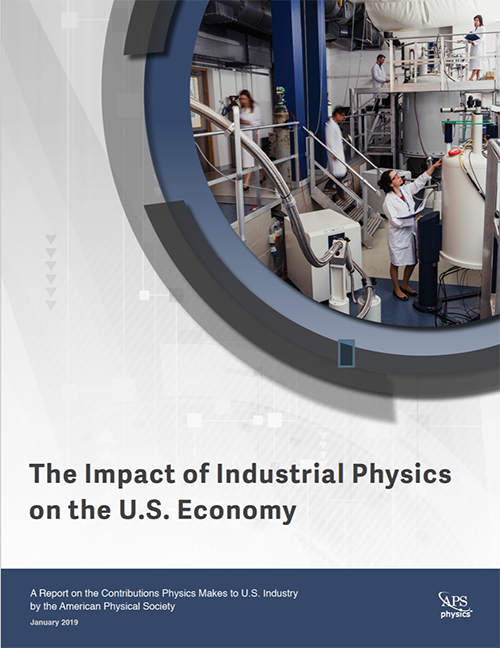The Impact of Industrial Physics on the U.S. Economy
Report 
1-page Summary of the Report 
Video of Press Conference on the Report held at the March Meeting 2019
Industrial physics is a major contributor to the economic well-being of the United States and makes its contribution in four major ways:
- The direct hire of college-trained physicists of all degrees
- Physics as an essential element in the training of scientists and engineers who work in industry
- The use of physical principles in the technology that creates products and services
- The emergence of new physics that drives disruptive changes to the economy
The American Physical Society, with support from the American Institute of Physics, recently sponsored an in-depth analysis of the impact of industrial physics on the U.S. economy. The major findings are given in the box on the right and detailed in this report.
In one way, the size of the impact is not surprising given the increasingly technological nature of our economy. For example, since 1946, industries such as computer hardware and software, semiconductor and sensor manufacturing, and consumer electronics, have grown dramatically and are major economic drivers today. These industries are the direct result of the exciting physics discoveries of the 20th century being transformed into products and services by industrial physicists and other scientists and engineers well-versed in physics.
This impact is anticipated to grow even larger in the future, and it is incumbent upon industry, academia, government, and physics professional societies to recognize the importance of nurturing industrial physics by training the next generation of industrial physicists, increasing the quality of physics training to non-physicists, and fully supporting industrial physicists as they pursue their careers. In addition, 21st-century industry will need new physics and a better understanding of our physical world, a goal that requires the United States to maintain its world leadership in physics R&D.
This project was managed by the APS Industrial Physics Advisory Board. This group of physicists work in the private sector and advise APS on issues related to industrial physics. The objective is to improve the engagement of APS with the non-academic physics community. More information about the IndBoard is available at the Advisory Board page.
This project was funded by APS and several generous donors. The AIP Venture Partnership Fund provided major support with a substantial grant. We gratefully acknowledge all of the organizations that supported this project:
American Institute of Physics Venture Partnership Fund
American Physical Society
APS Forum on Industrial and Applied Physics
Wyatt Technology Corp., Santa Barbara CA
Texas Instruments, Inc., Dallas TX
R&R Data Services, Gaithersburg MD
Availability: A limited number of printed copies of this report are available free of charge by contacting APS at Industrial.physics@aps.org. An electronic copy of the report is available free of charge.
There have been three similar reports prepared about the economic impact of physics in the UK, Italy, and the EU. You can find copies at these links:







Industrial physics directly produced an estimated 12.6% of the U.S. GDP in 2016, or about $2.3 trillion.
Direct employment related to industrial physics was about 11,500,000 people in 2016, which accounts for 6% of total U.S. employment.
U.S. exports by physics-based sectors are about $1.1 trillion (2016), which is approximately 20% of the value added (GDP) by those sectors.
In the period 2003 to 2016, approximately 70,000 degreed physicists joined the industry.
Between 2010 and 2016, over 340,000 patents with the classification of physics were received by U.S. companies.
In 2015, U.S. physics-based companies made internal R&D investments of over $150 billion.
Including indirect and induced contributions, industrial physics contributed approximately 30% of the U.S. GDP in 2016, or about $5.5 trillion.
Between 1966 and 2016, the value added (GDP) in physics-based sectors of U.S. industry grew by a factor of 22. At the same time, the GDP grew by a factor of about 4 (both in 2016 constant dollars).
